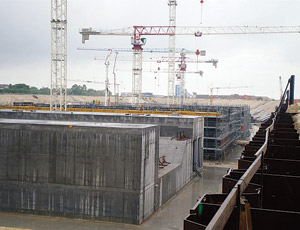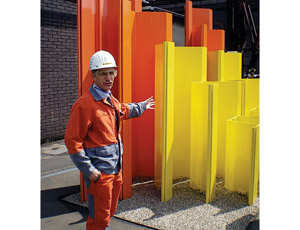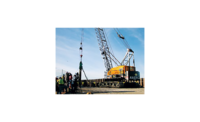In Venice, all eyes are on dramatic work at three lagoon inlets to hold back flood tides that repeatedly assault the historic Italian city. But along the mainland shore, engineers from the same construction consortium quietly are stemming more insidious flows of industrial pollution from Porto Marghera into the 550-sq-kilometer lagoon.


About two-thirds of a 57-km-long “fence” of sheet piling already has been driven to encircle polluted sites, says Alberto Bernstein, head of environmental engineering at Consorzio Venezia Nuova (CVN).
CVN is a consortium of numerous Italian contractors and design firms charged with developing and implementing the system to end lagoon flooding and improve its environment.
Industrial development began on reclamation in the Porto Marghera area, some 10 km across the lagoon, around the time of World War I, says Bernstein.
Various polluting industries, including petroleum refineries, settled there until the late 1960s. Around 3,500 hectares of industrial zone is now at risk from pollution, adds Bernstein. “The area leaks toward the lagoon,” he says.
CVN signed its large concession with the central government’s Venice Water Authority (VWA) in 2003, but it had started developing proposals a decade earlier. In 1995, the Water Authority, which has a wide infrastructure brief, decided to stem the flow of pollution from Porto Marghera.
The $1.2-billion plan, to be implemented by CVN, was to erect a “fence” around polluted sites allowing soil to be cleaned later for redevelopment, says Bernstein. “We decided to use sheet piles because it was quick and secure,” he says. “It seems to be a simple job � a lot of sheet piling. But you have to manage ground water [with] drainage systems,” he adds.
Typically, piles are driven through the roughly 12-meter-deep edge of fill to penetrate the bed by some 15 m. A concrete cap beam, about 4 m deep, is cast along the top of the piles, which are supported by ground anchors reaching back into the fill.
VWA ordered trials at a small artificial island that was reclaimed with World War ll bombing rubble and municipal waste, says Bernstein. Piling continues, with two-thirds of the planned 57-km-long piled wall done.
About 70% of the $960 million spent to date has been funded by the polluters, says Bernstein. With current funding rates, fencing polluted sites likely will go on for another five or six years, he forecasts.
Since starting work in 2004, CVN has completed over 60% of its main task, the flood-defense program known by its Italian acronym, MOSE. The consortium is casting 27 large concrete caissons that will accommodate 78 hinged steel flap gates, weighing about 300 tonnes each, across the lagoon’s Lido, Malamocco and Chioggia inlet beds.
Development work on the 160 spherical gate hinges, weighing about 40 tonnes each, is complete. Further, CVN has begun procuring steel for the hinges and the gates.
With extensive sheet piling, the Venice project has been good to the steel industry. Sheet piling is featured extensively in temporary and permanent structures at the various large dry dock, locks and harbors under construction along the inlets. Piles also support the sides of the trenches dredged across the inlets to accommodate the gate caissons.
As much as 200,000 tonnes of sheet piling is going into the project, estimates Daniel Kohnen, executive sales manager for the product at Luxembourg-based ArcelorMittal S.A. The firm has sold approximately 135,000 tonnes of sheet piles to contractors on some 40 MOSE projects, he adds.
For the steel producer, sheet piles are a very important key product, says Gonzalo Urquijo, group board member responsible for the sector. The company, in various incarnations, has been rolling sheet piles for 99 years in Luxembourg. Its plants there and in Poland have a combined production capacity of 900,000 tonnes a year, he adds.
In Luxembourg, ArcelorMittal has been recycling scrap metal since it stopped making steel there in 1997. The company garners some 3 million tonne of graded scrap a year from Luxembourg, France and Germany, says spokesman Lambert Schmit.
An electric arc furnace at the firm’s Esch-Belval facility melts the scrap for continuous casting into partially formed sections for rolling in the adjacent mill. The mill rolls so-called Larssen interlocks on Z-section sheet piles, which are supplied up to 70 centimeters wide. For Z-section sheets, “we are the only producer who succeeded in making this interlock,” says Roland Bastian, who runs the rolling mill.
ArcelorMittal got involved early in MOSE, supplying some 6,000 tonne of piling for gate trials 15 years ago, says Kohnen. The company stayed close to the project during its early developments. Getting the Italian engineers to overcome their preference for concrete construction was a major hurdle, he says.
Underwater piling was an area of concern, recalls Kohnen. Working from a jack-up barge “is the most difficult operation,” he adds. Convincing the Italians that piles would last 100 years was another challenge, he adds.
The company started supplying piles to Venice in late 2004. It now expects to sign its last MOSE contract, for around 1,800 tonnes, this year, says Kohnen. Subcontractor Piacentini Costruuzioni S.p.A., Modena, Italy, claims to have done around 90% of the flood schemes sheet piling.
With the MOSE program more than 60% done, gates are scheduled to be ready for operation in 2014, later than first planned because of budgetary constraints. CVN’s spokeswoman, Elena Zambardi, says MOSE’s cost remains unchanged in real terms at about $5.9 billion.




Post a comment to this article
Report Abusive Comment